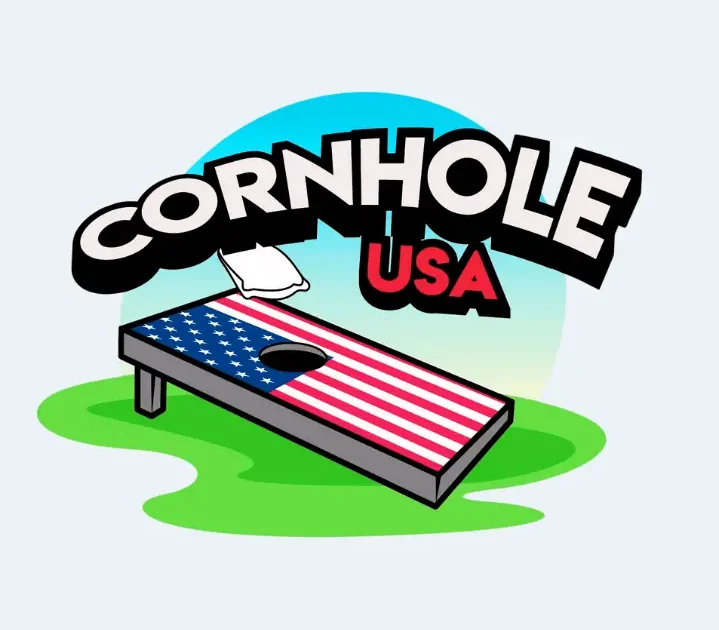Cornhole Distance & How Far Apart Are Cornhole Boards
Cornhole is an excellent and classic game widely recognized as one of the top outdoor games played worldwide recently. It’s an outdoor game you can enjoy on your home’s lawns and gardens at various family gatherings and picnics. With its competitive skill element, this game fosters solid friendships and family bonds.

The beauty of this game lies in its heart, the cornhole boards, which need to be placed in the right spot to impact the game significantly. We will delve into different aspects of cornhole distance, from regulations and official standards to strategic considerations and board dimensions.
Cornhole Spacing
A Crucial Factor In A Gameplay
In the game of cornhole, the boards are placed parallel to each other. The space between these boards is commonly referred to as cornhole spacing. This spacing is a crucial element for playing the game correctly.
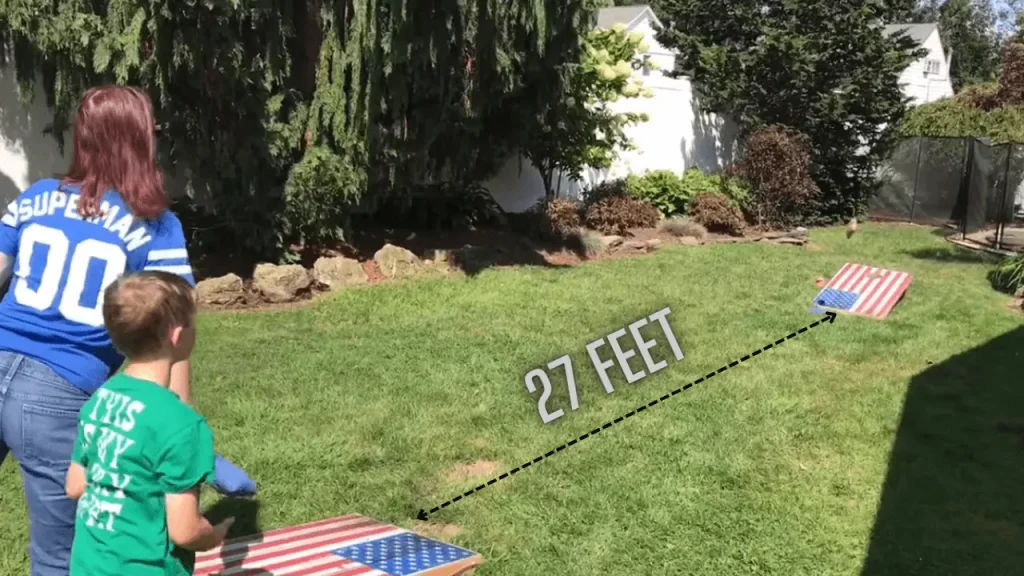
The distance determines the level of challenge, strategy, and fair play. Ensuring proper cornhole spacing is essential to creating a healthy environment for your tournaments, allowing all players to enjoy the game and showcase their skills fully.
Cornhole Official Distance
The term “cornhole official distance” epitomizes the precision and camaraderie inherent in the game. It delineates not merely a span of 27 feet between wooden platforms but rather a symbolic bridge between competitors and companionship. In this carefully measured expanse, under the sun’s warm embrace or the moon’s soft glow, friends and family gather to engage in the artistry of tossing bags, each of which is a testament to skill and connection.
Beyond the tangible measurements, the cornhole official distance becomes a metaphor for the gaps we bridge and the bonds we forge, as we revel in the simple joy of a bag finding its home while treasuring the shared moments that find theirs within our hearts.
Cornhole Distance Regulation
The distance of a cornhole is commonly known as the regulation distance. This is the universally accepted measurement for the distance between the front edges of two cornhole boards, measured edge to edge.
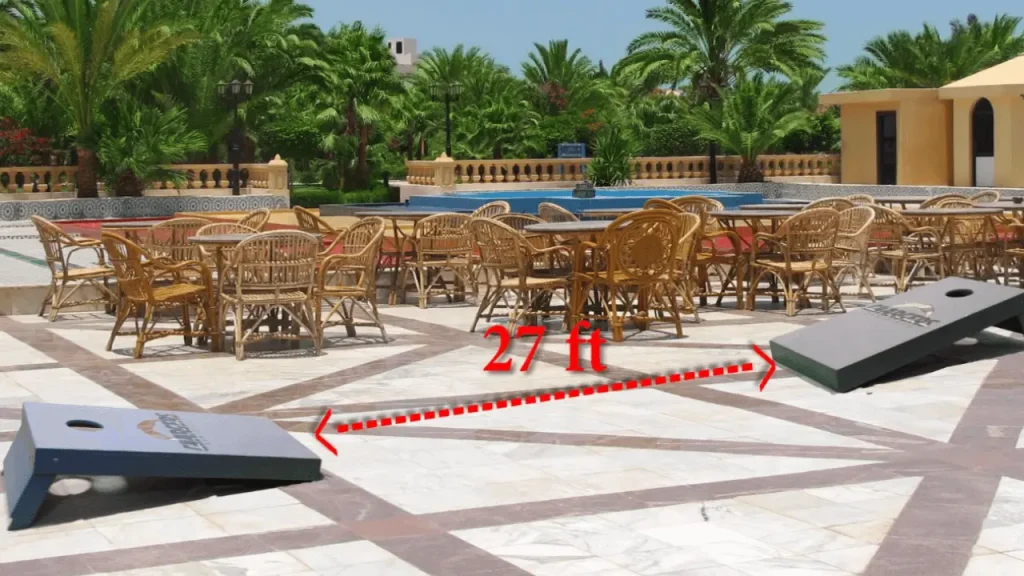
According to the rules and standards established by cornhole organizations and associations, the regulation distance between the front edges of two cornhole boards is precisely 27 feet. Whether it’s for tournaments or casual games, this distance needs to be set precisely as per this measurement. It is a crucial element of the game.
Cornhole Board Distance
Measuring The Challenge
The distance between the Cornhole Board and the player introduces a level of challenge, intrigue, and competition between players. Placing the Cornhole boards at a precise distance of 27 feet from the player has two essential aspects. Firstly, it adheres to the official Cornhole ACL Rules.
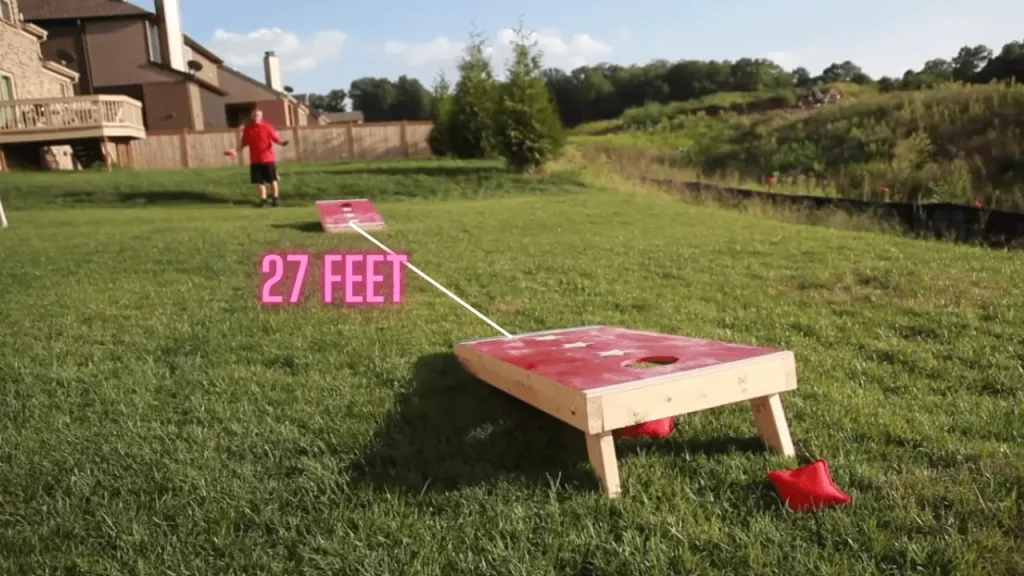
Secondly, it aids players in improving their skills and refining various strategies. The optimal board distance ensures that every throw demands thoughtful consideration, enhancing the game’s competitive aspect.
The Distance Between Cornhole Boards
Bridging Skill Levels
While the official distance remains a steadfast benchmark, flexibility is essential to accommodate players of varying skill levels. Adjusting distance can promote inclusivity and participation in informal settings or when introducing the game to newcomers. Shortening the space can give beginners a more accessible starting point before they graduate to the regulation distance.
Cornhole Dimensions
Beyond Distance
Cornhole dimensions encompass more than just the distance between boards. The size of the cornhole board itself, along with the diameter of the cornhole, contributes to the overall gameplay experience.
Regulation cornhole boards measure 2 feet in width and 4 feet in length, with a hole located 9 inches in diameter at the center of each board. These dimensions, combined with the standard distance of the cornhole board, create a balanced and captivating game.
Step-By-Step Game Setup
Setting up the cornhole game according to the official Cornhole Rules and correctly understanding the game’s strategy enhances the quality of play and contributes to becoming proficient. Playing the game in this manner increases the experience and assists a casual player in transitioning into a professional player. Here, a comprehensive guide to playing the cornhole game has been provided, which, when followed, can help one become a pro player.
1. Gathering Equipment
First, you must gather all the necessary equipment for playing the cornhole game in one place. The essential equipment includes 2 cornhole boards and 8 distinct cornhole bags. Of the 8 cornhole bags, 4 should be of one color, and the remaining 4 should be of another color.
2. Strategic Placement
The cornhole boards need to be set up in a parallel arrangement with each other. The distance between the front edges of the two boards should be set so that it is 27 feet from the front edge of one board to the front edge of the other. These settings are crucial to follow because they adhere to the professional cornhole official distance rules.
3. Player Positioning
The players or teams competing in the game stand in front of their respective boards and throw their bags toward the board. There is a foul line in front of each board, and players must stay behind it while making their throws.
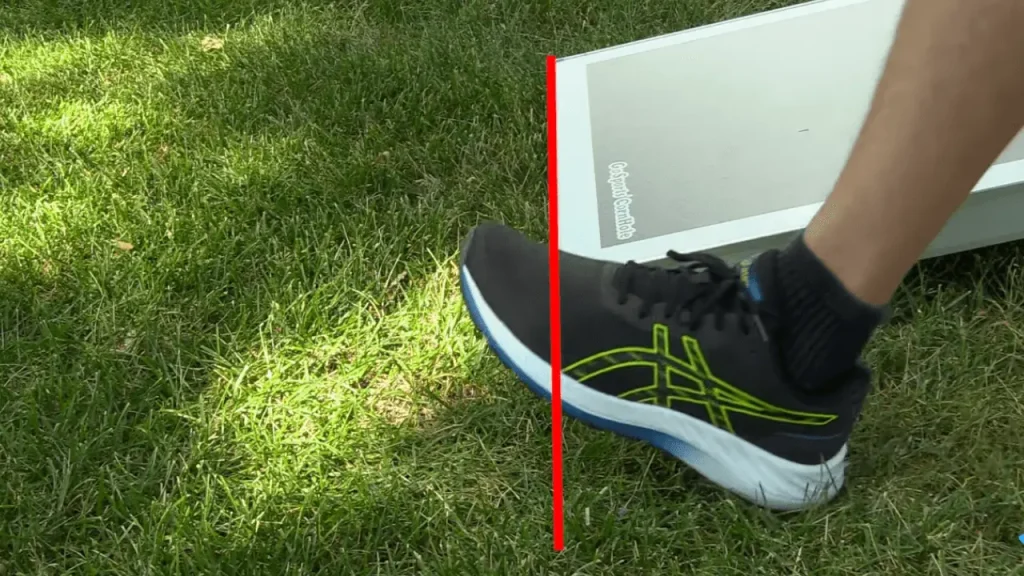
4. Cornhole Scoring Mechanism
In the cornhole game, scoring primarily revolves around the placement of bags. When a bag is thrown onto the board, if it remains on the board’s surface, the player earns 1 point. If the bag successfully goes through the hole, the player is awarded 3 points. Players accumulate points by throwing all four bags to collect as many points as possible.
In the scoring process, the team or player with the lower score has their points subtracted from the higher-scoring team’s points. The remaining points are then counted as the actual points for the higher-scoring team.
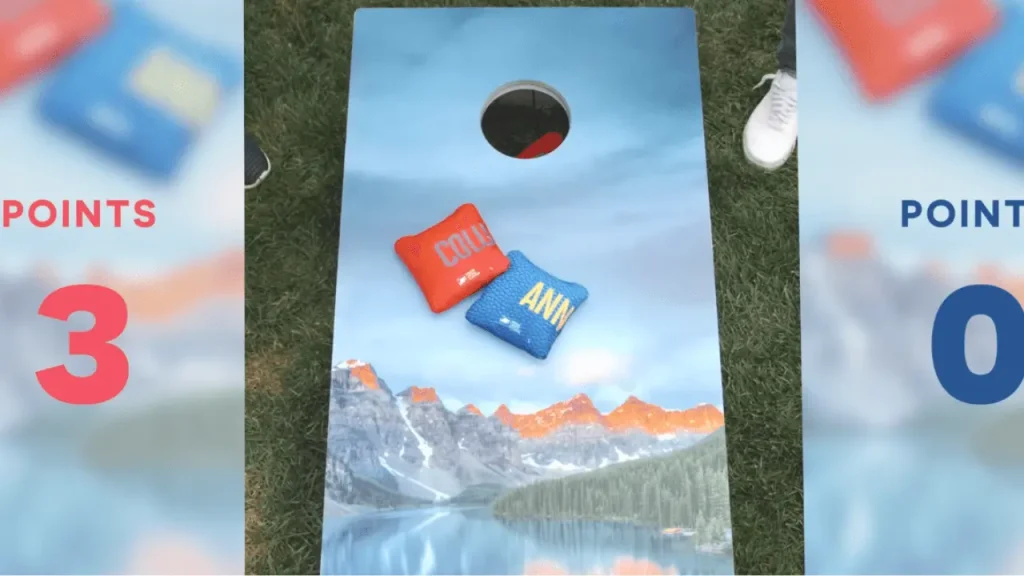
For instance, if Team A scores 5 points and Team B scores 10 points, after deducting Team A’s points from Team B’s points, Team B’s original score of 10 points becomes the actual score. This scoring system ensures a competitive and engaging gameplay experience in the cornhole game.
What happens if a bag falls into the target hole during raking?
If a bag falls into the target hole during raking in a game of cornhole, there is a specific rule that is applied. To ensure that the playing surface of the cornhole board remains undisturbed and in its natural state, all efforts should be made to prevent bags from falling inside the target hole unnaturally. However, if a bag is resting on a pile and unavoidably falls into the target hole due to the raking process, then it will be counted as 3 points. This means that accidentally causing a bag to fall into the target hole while raking will result in a score of 3 points for that particular bag.
What are the rules for pitching bags in an amateur cornhole?
In amateur cornhole, there are specific rules and guidelines to follow when pitching bags. Here is a thorough explanation of these rules:
- Pitching Rotation: Players take turns pitching their bags, with only one player pitching at a time. Each player will pitch all four of their bags before it is the next player’s turn.
- Player Positioning: During the pitching motion, both feet of the player must remain within the designated pitcher’s box. They are not allowed to step outside of this area. This ensures fair play and maintains an equal distance from the cornhole boards.
- Crossing the Foul Line: Players must refrain from crossing the foul line until the bag they pitched has completely landed on the cornhole board. Crossing the foul line prematurely can result in a foul and may negatively impact the score.
- Scoring and Pitching Order: The player who achieved the highest score in the previous round will have the privilege of pitching first in the subsequent round. This scoring system encourages competition and provides an advantage to the player who performed better in the previous frame.
By adhering to these rules, amateur cornhole players can ensure a fair and enjoyable game for all participants. These regulations help maintain consistency and fairness throughout the game.
What are the options for playing the game, both in singles and doubles?
In this passage, we will explore the different options for playing the game in both singles and doubles formats:
Singles Play:
In singles play, Player A and Player B compete against each other. At the beginning of the game, a coin flip determines which side each player will play on. Players will then walk from one board to the other without crossing to the other side and play exclusively on that side. The player who wins the coin flip gets to choose their preferred side. During the game, players start at the headboard and take turns pitching bags until each player has thrown all four of their bags. Once all four bags are pitched, the score for that round is calculated, and then the bags are raked. The player who scored the most in the previous round will have the privilege of pitching first in the next round.
Doubles Play:
In doubles play, two teams, Team A and Team B, compete against each other. Each team consists of two players. Similar to singles play, a coin flip at the start of the game determines which side each team will play on. The winning team of the coin flip chooses their desired side. Just like in singles play, players will walk from one board to the other without crossing to the other side and play exclusively on their chosen side. To begin the game, one team will pitch all of their bags, alternating between the two players until each player has pitched four bags. Then, the second team will take their turn, also alternating pitches between their two players until each player has thrown all four bags.
In summary, singles play involves a player competing against another player, where each player walks from one board to the other, pitching bags exclusively on their chosen side. Doubles play, on the other hand, consists of two teams, each with two players, competing against each other. Like in singles play, players walk from one board to the other and pitch bags exclusively on their assigned side. Both formats have their own unique rules and strategies for determining the winner of the game.
How is scoring determined in amateur cornhole?
In amateur cornhole, scoring is determined based on a set of rules. The most common method to declare a winner is by reaching or exceeding a total of 21 points. The game is divided into frames, which are defined by a player or team pitching all their bags to the opposite end of the court.
During each frame, players must pitch all their bags from the same side, known as the pitching area, and are not allowed to switch sides. Scoring is based on the position and outcome of the bags after they are thrown. A bag that lands and remains on the board surface will count as 1 point, while a bag that goes through the target hole will count as 3 points. On the other hand, a bag that lands on the surface but falls off or fails to go through the target hole will not count for any points.
Cancellation scoring is a suggested method of scoring in amateur cornhole. With cancellation scoring, each team or player’s points cancel out the points of the opposing team or player. For example, in a frame where Team A/Player A throws one bag on the playing surface and another bag in the target hole, and Team B/Player A throws one bag on the playing surface, the final score for this frame would be Team A receiving 3 points (for the bag in the target hole) and Team B receiving zero points (as their bag on the board cancels out Team A’s bag).
By using this scoring system, the winner of the game is determined by reaching or exceeding a total of 21 points while taking into account the cancellation of points between teams or players.
How should the court be laid out for amateur cornhole?
For amateur cornhole, the court should be designed with specific dimensions and guidelines. Firstly, the two cornhole boards should be positioned with a spacing of either 27 feet apart from the front edge to the front edge for competitive or professional level play or 24 feet for amateur or social level play.
Each pitcher is allotted a dedicated throwing area, which measures 4 feet by 3 feet on either side of the board. This space is where the players pitch or toss their cornhole bags.
To establish the boundaries, the front of the board serves as the foul line. It is paramount that this line is not crossed at any time during the throwing or pitching action. Players must remain behind the foul line when making their throws.
What are the equipment requirements for playing amateur cornhole?
To play amateur cornhole, you will need the following equipment:
1. Boards: Two boards are required, each measuring 24″ x 48″. The boards should have a 6″ diameter hole that is centered 9″ from the top and 12″ from side to side. The front of the board should be 3-4″ high from the top of the playing surface to the ground, while the back should be 12″ high from the top of the playing surface to the ground.
2. Bags: Eight bags in total are needed, with 4 bags for each player. The bags should be of similar color. Each bag should measure 6″ x 6″ in size. The weight of each bag should fall between 15 and 16 oz. The bags can be filled with either whole kernel corn or resin pellets.
3. Outer Material: The outer material of the bags can be made from various options, such as canvas, duck cloth, twill, or synthetic sued.
By having these equipment requirements fulfilled, you will be ready to enjoy a game of amateur cornhole.
Conclusion
A Game of Precision and Camaraderie
Cornhole is a testament to precision, strategy, and friendly competition in outdoor gaming. The distance between cornhole boards is pivotal in shaping the game’s dynamics and ensuring fairness for all participants.
Whether you’re a casual player seeking leisurely entertainment or a dedicated enthusiast vying for victory, understanding and respecting the official cornhole distance adds an extra layer of enjoyment to this beloved pastime.
So, the next time you gather your corn bags and boards, remember that the 27-foot separation isn’t just a measurement; it’s a fundamental element that brings players together for memorable moments of fun and camaraderie.
